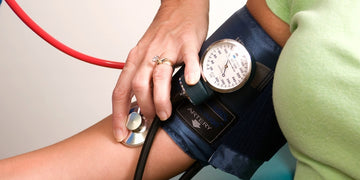What are the symptoms of high blood pressure in women?

High blood pressure, known as hypertension, is usually asymptomatic until it becomes a severe problem. So, what can you do to prevent potential issues and maintain (or improve) your blood pressure? We’ll go over the different categories of high blood pressure, factors that can impact blood pressure levels, and ways to manage high blood pressure.
What is blood pressure? How is it measured?
Blood pressure is defined as the force of your blood pushing against the walls of your arteries, which carry blood from your heart to other parts of your body. It’s measured using two numbers. The first number represents the systolic pressure, which is the pressure (force) of blood against your arterial walls caused by your heartbeat. The second number indicates the diastolic pressure, which measures the pressure in your arteries between heartbeats. Millimeters of mercury (mm Hg) is the unit used to measure blood pressure.
There are 5 categories of blood pressure:
- Normal blood pressure is below 120/80 mm Hg.
- With prehypertension, known as elevated blood pressure, systolic pressure ranges from 120-129 mm Hg while diastolic remains below 80 mm Hg.
- Stage 1 hypertension occurs if your blood pressure has systolic measurements between 130-139 mm Hg or diastolic measurements of 80-89 mm Hg.
- Stage 2 hypertension is caused by your systolic pressure being at 140+ mm Hg or diastolic pressure measuring at 90+ mm Hg.
- A hypertensive crisis occurs when measurements are higher than 180/120 mm Hg. Readings this high require urgent medical care to prevent damage.
As you age, isolated systolic hypertension becomes more likely particularly if you’re over the age of 65. With this condition, your diastolic pressure remains under 80 mm Hg, but your systolic pressure climbs to 130+ mm Hg. This type of hypertension requires immediate medical care. Please see your primary care provider if you ever find your blood pressure to be this high.
Causes of high blood pressure
The cause of primary hypertension is usually unidentifiable and develops slowly over many years. The specific cause of primary hypertension might be hard to pinpoint, but you can often identify the contributing factors. Risk factors include:
- Dietary choices such as having too much salt or alcohol, or too little potassium
- Lack of physical activity
- Poor stress management
- Demographics like age, race, and genetics (get to know your family history)
- Significant weight gain or some other chronic conditions
- Tobacco use
The other type of high blood pressure, called secondary hypertension, can be caused by another underlying condition. It can appear suddenly and lead to more severe high blood pressure than primary hypertension. Factors that can lead to secondary hypertension include:
- Birth control, cold medicine, pain relievers, or other medications
- Kidney disease
- Thyroid issues
Health impacts of high blood pressure
Two main factors affect what high blood pressure can do to you: the intensity of blood pressure (it gets more dangerous the higher your blood pressure climbs) and how long your blood pressure has been at high levels without being treated. Extreme blood pressure leads to blood vessel and organ damage. Extremely high blood pressure can lead to symptoms like:
- Chest pain or difficulty breathing
- Fatigue or confusion
- Vision problems or nosebleeds
- Headaches
- Pounding in the chest, neck, or ears
- Blood when you pee
If you don’t manage your high blood pressure, you might experience health complications. Possible complications of long term, untreated hypertension include:
- Dementia and other memory or problems understanding
- Vision loss
- Kidney trouble (which can lead to kidney failure)
- Pregnancy complications
- Metabolic disorders
- Heart attack, stroke, or heart failure
How do you manage high blood pressure?
Your blood pressure should be measured at least every two years once you turn 18. Your primary care provider might do readings more frequently if you’re 40+ years (or younger if you’re at high risk for high blood pressure). Due to white coat hypertension, or elevated blood pressure at the doctor’s office, a single reading of high blood pressure does not automatically mean you will be diagnosed with hypertension. Your primary care provider will most likely check your blood pressure several times at separate appointments before diagnosing you with high blood pressure.
See a doctor if you have any of the symptoms associated with high blood pressure. A hypertensive crisis, a condition in which your blood pressure is over 180/120, may lead to a heart attack or stroke. If you have high blood pressure or are at risk of high blood pressure, your primary care provider may want you to monitor your blood pressure at home. If you’re using a home blood pressure machine, be sure to maintain it by checking its accuracy annually.
Treatment options for high blood pressure
You may need to make changes to your lifestyle to help manage high blood pressure. These changes include:
- Reducing alcohol and salt in your diet (optimally use less than 1,500 mg sodium, or 3.75 g of salt, per day)
- Exercising regularly
- Losing weight or maintaining a healthy weight
- Avoiding tobacco products
- Managing anger and stress
When lifestyle changes aren’t enough, your primary care provider might prescribe medications to help manage your condition. Your treatment depends on the type of high blood pressure you’re experiencing and your overall health prognosis. You can discuss specific treatment goals and options with your primary care physician.
By getting regular checkups with your doctor, you can stay ahead of potential problems from high blood pressure.
Keep Reading

High blood pressure in women: What you need to know
Sep 29

Taking Care of Your Heart: Managing risk of cardiovascular disease
Feb 4

What are common heart attack symptoms in women?
Jul 12








